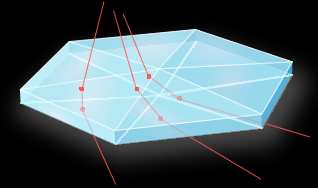Ellipses & Circles
Rare elliptical halos and a complete paraselenic circle (below) captured by Adam Kraft on the night of 7/8 February at Spring Arbor, Michigan.
All images ©Adam Kraft, shown with permission
Elliptical halos are small, a few degrees across and of varying �ovality�. Some have one ring while others sport several and not necessary centred on the moon or sun making them.
Adam�s lunar halo varied in size and form over two hours as the samples at middle left show. The moon was 51.5 degrees high In the top image and the halo measured 4.7 by 3.8�.
The arc curving through the moon is a paraselenic circle - see the lowest image.
Elliptical halos might be made by rays passing through very �flat� pyramidal ice crystals. These would effectively form prisms of just a few degrees and enough to produce the necessary small extent of refraction.
Several ray paths are possible and give a variety of ovals. At lower left HaloSim ray tracings simulate several halos for a moon 51.5� high. Their variety comes from small variations in relative sizes of crystal facets and pyramidal angles. Extensive parameter adjustment and use of more than one crystal type could start to match a particular observed halo. But the match is rarely perfect and it is an unfruitful exercise that we learn little from.
There is a deeper issue. The required pyramidal angles are very unphysical, counter to crystallographic theory. Other ice forms like dendritic snowflakes might be responsible.
An elliptical mystery.

|



